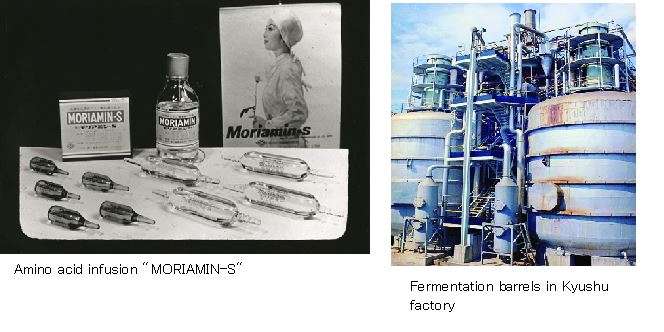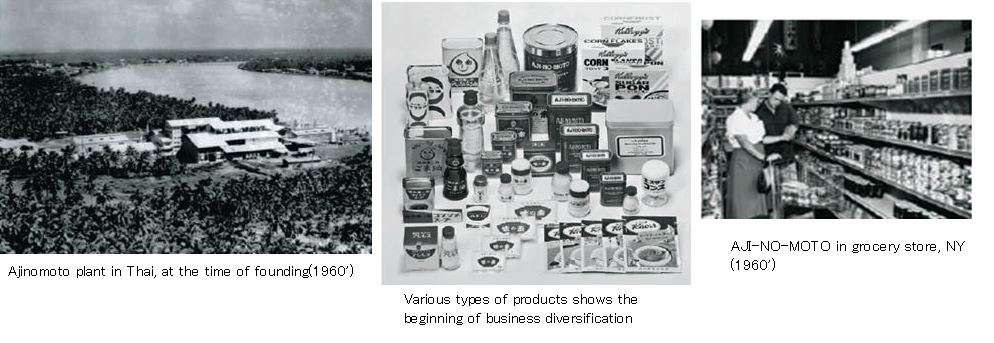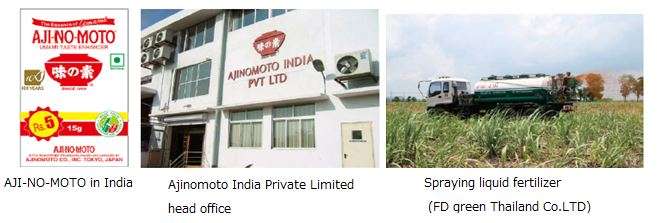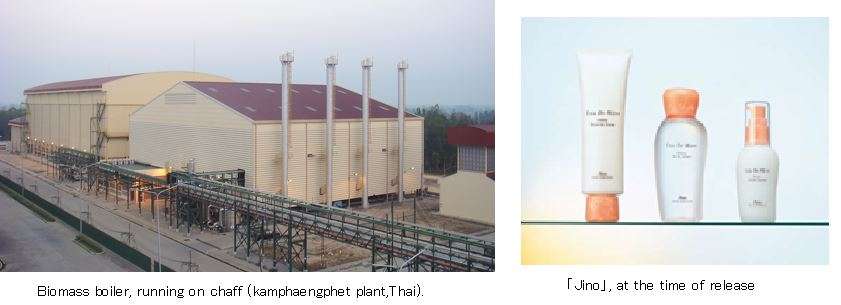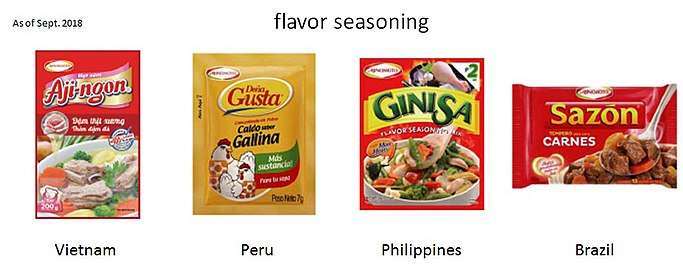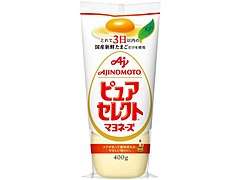Ajinomoto
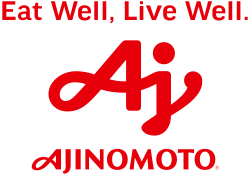 Eat Well, Live Well. | |
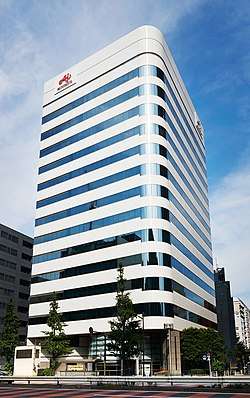 | |
Native name | 味の素株式会社 |
|---|---|
Romanized name | Ajinomoto Kabushiki-gaisha |
| Public (K.K.) | |
| Traded as |
TYO: 2802 MYX: 2658 TOPIX Large 70 Component |
| Industry | Food industry |
| Founded |
17 June 1917 (as S. Suzuki & Co. Ltd.) |
| Headquarters | Chūō, Tokyo, Japan |
Area served | Worldwide |
Key people | Takaaki Nishii (President & Chief Executive Officer) |
| Products | seasonings, cooking oils, TV dinners, sweeteners, amino acids and pharmaceuticals |
| Revenue |
|
|
| |
|
| |
| Total assets |
|
| Total equity |
|
Number of employees | 32,734 (2017)[1] |
| Website | Ajinomoto Group |
Ajinomoto Co., Inc. (味の素株式会社 Ajinomoto Kabushiki gaisha) is a Japanese food and chemical corporation which produces seasonings, cooking oils, frozen foods, beverage, sweeteners, amino acids, and pharmaceuticals.
AJI-NO-MOTO (味の素, "essence of taste") is the trade name for the company’s original monosodium glutamate (MSG) product.[2]
The company's head office is located in Chūō, Tokyo.[3]
Ajinomoto operates in 35 countries, employing around 32,734 people as of 2017.[1] Its yearly revenue in the fiscal year of 2017 stands at around US$10.5 billion.[1]
History
The Origin of Ajinomoto Co.,Inc. 1907 – 1909
The origin of Ajinomoto Co., Inc. was a newly organized business unit in 1908 in Suzuki Pharmaceutical Co., Ltd., founded in May 1907 by Saburosuke Suzuki II. This unit was organized at a request of Dr. Kikunae Ikeda (1864-1936), a Professor at Tokyo Imperial University, who invented a method for producing monosodium glutamate seasoning. He wanted to commercialize his discovery and by working with Sabururosuke Suzuki II to make this a reality in 1909. Under the general control of Saburosuke, Chuji Suzuki, a younger brother of Saburosuke, was in charge of the production and Saburo Suzuki, a son of Saburosuke, handled sales and marketing.[4] Dr. Ikeda was interested in the taste of kelp juice and when analyzing samples, he discovered the causative substance of its unique flavor, was monosodium glutamate (MSG). He named this specific taste "umami.". Umami is now accepted around the world as one of the essential basic tastes, but it was not yet known at the time of discovery.[5] Ikeda further invented a method of manufacturing MSG, and acquired patents in Japan in 1908, France in 1909, UK in 1910, and in the United States in 1912.[6] After obtaining a Japanese patent, Ikeda was inspired by an article written by a Japanese doctor, Hide Miyake, claiming that the flavor of umami facilitated digestion. Subsequently, in order to use umami to improve the health of the Japanese at that time., he asked Saburosuke Suzuki II to further commercialize it for general consumption.[7] [8] The product name "AJI-NO-MOTO," which continues to be used today, represents a seasoning that is made from vegetable proteins such as wheat and soybean. In November 1908, the company registered their trademark for "“AJI-NO-MOTO"” with a woman wearing traditional Japanese-style clothes (Trademark Registration No. 34220). In parallel, in October 1908, prior to the start of manufacturing and in consideration of safety issues, the company conducted an evaluation test of monosodium glutamate at the Tokyo Sanitation Laboratory of the Ministry of the Interior. Test results and evaluations showed that the product was harmless and suitable for human consumption. As a result, full-scale production began in December 1908 and products were mass-produced by March the following year. After presenting the product at an exhibition at the first new product exhibition event held in Ueno, Tokyo, in April 1909,[8] sales for general consumers began on May 20th 1909.[9] This is the founding anniversary of the business.[10]
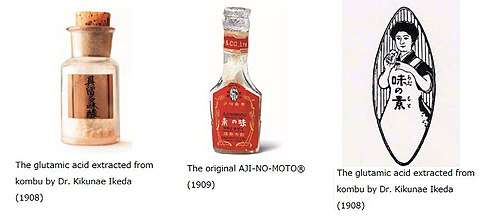
1910s "The Expansion of Production, Sales and Exports"
Since its release, “AJI-NO-MOTO“” focused on housewives as the main target users, hence various promotional activities such as newspaper advertisements using the registered trademark of a housewife in an apron, signboards and ground stamps (a kind of small Geoglyphs) were conducted.[7][9] Sales gradually increased and the output also increased from 4.7 ton in 1910 to 23.3 ton in 1913. In 1914, in order to continue to expand production, a new plant was set-up in Kawasaki.[11] Additionally, there was a special economic stimulus after the First World War which resulted in output hitting 84.,6 ton in 1918 and sales expanding from 400,000 yen in 1913 to 1,563,000 yen. However, in terms of profit, the company experienced a permanent deficit for the first ten years due to failings in the changing method of the production at the new Kawasaki plant, and price cuts aimed at penetrating ordinary households, among other reasons. Under these circumstances, from a management perspective, Saburosuke Suzuki II considered that a further expansion was necessary and on June 17, 1917 he founded S.Suzuki & Co., Ltd. with 3 million yen. This day is the company’s founding anniversary.[10]
The exceptional demands of the First World War also brought about an increase in exports so Saburosuke Suzuki II focused his efforts on expanding overseas markets. Sales dealers began in Taiwan in May 1910, in Korea in August 1910 and in China in September 1914. In addition, a New York office was opened in 1917, followed by a Shanghai branch office in 1918. Exports hit 20.5 ton in 1918, accounting for a quarter of total output.[9][11]
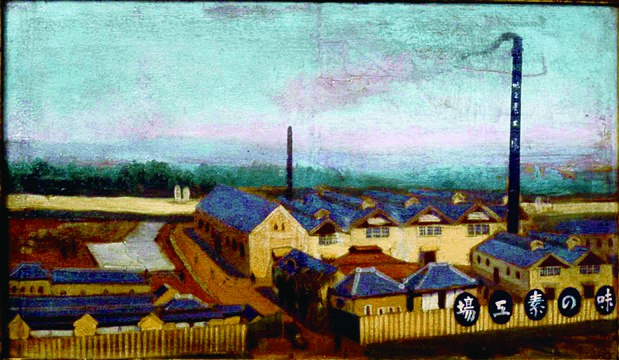 Kawasaki factory
Kawasaki factory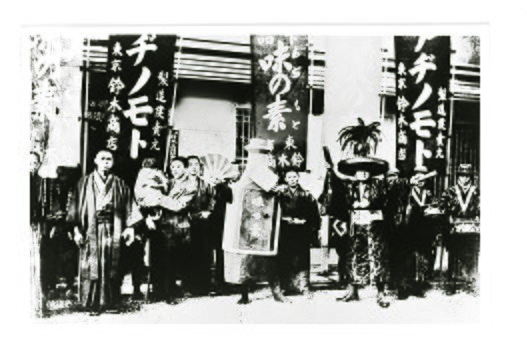 Promotion by Chindon'ya
Promotion by Chindon'ya
1920’s - 1930's “Overcoming Difficulties and Expanding Exports“
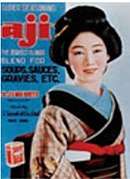
Sales of AJI-NO-MOTO increased 3.8 times over ten years from 2,799 thousand yen in 1920 to 10,543 thousand yen in 1929. The expansion of sales channels to overseas markets played a major part in this sales increase. In addition to setting up distributors in Taiwan, Korea, and China, in the 1910s, the company also opened offices in Singapore and Hong Kong in 1927, an office in Taiwan in 1929, and further expanded their sales bases throughout South East Asia. In the United States, they focused on the New York branch and continued to develop a market for AJI-NO-MOTO.[12] In the 1930s, the production and sales of AJI-NO-MOTO increased from 1,077 tons in 1931 to 3,750 tons in 1937, equivalent respectively to 13 million yen and 27 million yen, an increase of about 3.5 times in production volume and 2.1 times in sales. Meanwhile, in order to realize the potential of mass production, they made further developments to the conversion process of the AJI-NO-MOTO raw material, from wheat to soybean, which became available at a lower price.[13]
In the United States, domestic sales to general households at the time were insignificant, however, in 1931, as a result of mass orders from Heinz (H.J. Heinz, Co.), and Campbell Soup Co., the company was able to expand their U.S. sales channels to the processed food market. In relation to the Food Laws in the U.S., the raw material used in AJI-NO-MOTO was labelled a "Vegetable Protein Derivative."
Meanwhile, in 1933, Japan withdrew from the League of Nations; their isolation from the world advanced, and shifted to a full-scale wartime economic regime in 1938.[14] As a result, the production of AJI-NO-MOTO also suffered, and the production volume declined to 2,339 tons in 1940, from a peak output of 3,750 tons in 1937.[15]
1940’s “Production Suspension During Wartime and Production Restoration Post-War”

After 1940, production of AJI-NO-MOTO continued to decline, reducing production to 1,000 tons in 1942 before ceasing production in 1944, during World War II.
In the post-war period, the president, Saburosuke Ⅲ, showed a new company policy for resuming production. However, it took time to rebuild the factories as the company suffered from a lack of funds and raw materials. As a consequence, production restarted in 1947. In the meantime, the company worked on its general maintenance by producing other foods and food-related items and securing employment. After restarting production, with overseas markets being favorably receptive to the quality of AJI-NO-MOTO, its export became the driving force to the development of the company as a means to acquire foreign currency, with the export ratio in 1950 reaching 95%.[15][16]
In April 1946 the company changed their name to the Ajinomoto Co., Ltd. and when the Japanese stock exchange restarted in May 1949, the company listed their stock.[17]
1950s -1970s "Diversification and internationalization"
During the 1950s, export of “AJI-NO-MOTO” grew steadily overall. Export to Southeast Asia and Europe increased remarkably, while export to the U.S., which accounted for more than 20% of total export in 1950, increased slightly. With regard to Europe, adoption of “AJI-NO-MOTO” as a seasoning by many processed food manufacturers, such as Maggie GmbH and C.H. Knorr AG, helped the region occupy half of the total export volume, about 3,000 tons in 1955. Meanwhile, in Asia, export expanded from East Asia to Singapore, Thailand, Myanmar, the Philippines, Malaysia and Indonesia.[18] In 1950, sales in Japan also resumed more vigorously after postwar sales controls were lifted. Sales expanded in a short period of time and by 1953, they exceeded the pre-war sales volume.[19] In addition to “AJI-NO-MOTO”, the company expanded its business to produce nucleic acid based seasonings etc., and introduced processed food products such as soups through tie-ups with external resources. In the 1960s, there was a revolutionary process conversion in the technology used to manufacture “AJI-NO-MOTO.” The main ingredient of “AJI-NO-MOTO” is monosodium glutamate, which is a sodium salt of glutamic acid. Glutamic acid is one of twenty basic amino acids found in natural protein of vegetable, meat and fish. Until the 1960s, “AJI-NO-MOTO” was manufactured by extraction by hydrolyzing soybean protein, but the company succeeded in mass production of amino acids by using microorganisms and sugar cane as raw material – this process is known as the fermentation method. As a result of this development in technology, local production in the countries, where “AJI-NO-MOTO” was imported, could be quickly implemented. Domestic production began in Thailand in 1962, followed by the Philippines (1962), Malaysia (1965), Peru (1969), Indonesia (1970) and Brazil (1977). Production volume in the six countries exceeded 51 thousand tons in 1979, approximately 90% of in Japan.[20] Meanwhile, in the 1960s, diversification into the food business sector accelerated through the alliances with international food companies. In 1962, they cooperated with Kellogg Company in the U.S. to manufacture and sell cornflakes. In 1963, they began a partnership with CPC International Inc., which owned a major soup manufacturer C.H. Knorr AG in Germany, and a major mayonnaise and margarine manufacturer Best Foods Company Ltd. in the U.S. Ajinomoto Co., Inc. expanded its food business by launching “Knorr” soup in 1964 and their own mayonnaise in 1968.[21] In the 1970s, there were further advancements in diversification. They launched a flavor seasoning “Hon-dashi” in 1970, frozen foods in 1972, and by establishing Ajinomoto General Foods Inc. (AGF), in partnership with General Foods Inc., started instant coffee business in 1973. In 1978, they launched menu-specific seasons for Chinese dishes under the brand name, “Cook Do.” The main products under this brand are still on sale in 2018.[19][22] In the overseas food business, the company developed consumer foods business mainly in Asian and Latin American markets, where “AJI-NO-MOTO” was produced locally. In Europe and the U.S., expansion was concerned with dealing in bulk business with processed food manufacturers. In fields other than the food business, various kinds of amino acids products were produced using the new technology. In 1956, the company began supplying crystalline amino acids for pharmaceutical use, contributing to the world's first release of amino acids infusion. In the 1960s and 1970s they developed feed-use amino acids, pharmaceuticals such as enteral nutrients, and specialty chemicals such as surfactants. In terms of overseas deployment, feed use amino acids occupied a large part of the bulk business in Europe and the U.S.[20]
1980s – 1990s “Expansion & Restructuring”
Since the 1980s, a key concept behind the growth of the Ajinomoto Group was developing and diversifying internationally in the same way that the company did during the 1970s. During the international expansion there was a background of structural change occurring in the Japanese economy. In 1973 and 1979 the growth rate declined after the oil shock and Japanese firms faced an appreciation of the yen due to the Plaza Accord in 1985. [23] This resulted in companies shifting to overseas production in earnest. Similarly, for Ajinomoto, they increased their number of employees in major overseas affiliates from less than 4,000 in 1979 to more than 11,000 in 1996. They also expanded MSG production outside of Japan and by 1996 had production bases in 10 countries.
With regard to the seasoning business, Ajinomoto Co., Inc. set up overseas affiliates in Vietnam and Nigeria in 1991, and in Henan Province, China in 1993. Their approach to retail in each country was to try and penetrate the market with cash transaction at the core. Beginning in 1979 with the launch of Ros Dee® in Thailand, AJI-NO-MOTO continued to develop, produce and sell flavor seasons (savory seasonings) in Indonesia, the Philippines, Malaysia and Brazil. In 1986, the Ajinomoto Group began producing Lysine in their Iowa factory of Heartland Lysine Co. U.S.A. followed by production in their Pathum Than factory in Ajinomoto Thailand in 1986, and Bio Italia, BioPro in Italy in 1992, gradually upgrading their worldwide production bases. In the United States, competitors were also trying to increase Lysine production which resulted in issues in the pricing of the product due to oversupply. [24]
In the circumstances, the Lysine price fixing cartel occurred in the end mid-1990s. Along with Kyowa Hakko Kogyo, and Sewon America Inc., Ajinomoto settled with the United States Department of Justice Antitrust Division in September 1996. Each firm and one executive from each pleaded guilty as part of a plea bargain to aid in further investigation. Their cooperation led to Archer Daniels Midland settling charges with the US Government in October 1996 for $100 million, a record antitrust fine at the time.[25] The cartel had been able to raise Lysine prices 70% within their first six months of cooperation.[26]
With regard to diversification, until the end of the 1970s, the Ajinomoto Group continued the diversification of oils, consommé, soups, frozen foods, and other products in the food business, but from 1980 they focused on the diversification of the amino acid business. Following the USFDA's re-approval of the sweetener aspartame in 1981, the Ajinomoto Group continued to complete the production process of aspartame at the Tokai Plant in 1982, filed related patents, and subsequently acquired a number of additional development patents.
Along with the development of aspartame, in 1987, the Ajinomoto Group began conducting research on drug development in the fields of clinical nutrition, anti-cancer drugs, infectious diseases, and cardiovascular drugs; developing ELENTAL® for use in clinical nutrition, LIVACT® used in fighting liver disease and in collaboration with the Japanese Foundation for Cancer Research they developed and commercialized Lentinan. Subsequently, they continued to study fabricated materials and chemical products, leading to the development of JINO in cosmetics and amino acids for athletes, with a sports supplement, "Amino Vital" being released in 1995. [24] From the late 1970s to the early 1980s, many Japanese companies developed long-term strategies and Corporate Identity (CI) activities to respond to environmental changes. [27]
Ajinomoto also mapped out a long-term business plan in 1975, formulating a three-year plan from 1976, redeveloping another long-term management concept in 1984 and from 1988 they devised the "WE-21" strategy. WE-21 stands for World Excellence in the 21st Century, showing how the company aimed to be the world's leading enterprise. In terms of communication, in 1985, Ajinomoto established a new corporate communication symbol known as the New Ajinomoto Communication Symbol or "NACS." [24]
The safety of MSG, as related to the corporate image of Ajinomoto, has been a point of discussion since its inception. The discussion began as early as 1910 in Japan, with unsubstantiated rumors relating to the use of serpents in the raw materials. Since the 1940s, safety concerns have been voiced several times by public institutions in both Japan and the United States. Additional concerns included the Chinese Restaurant Syndrome in the 1960s and the call for greater regulation on the use of MSG, which was based on the work of Professor John Olney, in 1969.
In 1996, the FDA commissioned the Federation of American Society for Experimental Biology (FASEB) to study the effects of MSG and they concluded that it is safe for the majority of people.
At that time, Ajinomoto also noted the possibility that asthma patients and carriers with symptoms of Chinese Restaurant Syndrome symptoms may be affected, but ultimately, the safety of this group was also confirmed by the subsequent test results in the United States and Australia. [28] [29]

In 1999, Ajinomoto formulated a new logotype and slogan. The logotype uses a capital letter A that combines the infinity symbol and the slogan "A Taste of the Future." This is the corporate philosophy of the Ajinomoto Group. They take a global perspective on “food” and “health” – with these two key concepts at the core, Ajinomoto believes that it will contribute to a better life tomorrow. [30]
2000s
By mid-2000, Ajinomoto's acquisition of NutraSweet and 'Euro-Aspartame' from Monsanto had been completed.[31]
In early 2001, Ajinomoto was involved in a scandal in majority-Muslim Indonesia when it emerged that a pork-based enzyme had been used in its production of MSG.[32]
In January 2006, the company bought the cooking sauce and condiments manufacturer Amoy Food from the French dairy product company Groupe Danone, which had run the division as the "Amoy Asian food unit".[33] At the time of the acquisition, Ajinomoto was the largest Japanese maker of seasonings.[33]
Lawsuits against Asda (2008–2010) In 2008, Ajinomoto sued British supermarket chain Asda, part of Wal-Mart, for a malicious falsehood action concerning its aspartame product when the chemical was listed as excluded from the chain's product line along with other "nasties".[34] In July 2009, a British court found in favour of Asda.[35] In June 2010, an appeal court reversed the decision, allowing Ajinomoto to pursue a case against Asda to protect aspartame's reputation.[36] At that time, Asda said that it would continue to use the term "no nasties" on its own-label products,[37] however, the suit was settled out of court in 2011 after Asda removed references to aspartame from its packaging.[38]
In 2008 and 2009, Holyland Marketing (P) Ltd.[39] filed rectification petition against Ajinomoto Co. Inc (India) to genericide the trademark "AJINOMOTO" for MSG product. Matter is pending with IPAB.[40]
2010 to present
In late 2012, the Company sold its Calpis beverage unit to Asahi Breweries for US$1,500,000,000.[41]

In 2013, the Company acquired the contract manufacturing organization Althea Technologies for US$175,000,000 in a bid to expand biopharmaceutical manufacturing in the United States.[42] In October 2017, Ajinomoto introduced a “Global Brand Logo” for use throughout the Ajinomoto group.[43]
Food Products Business
In 1909, Ajinomoto Co. Inc. released their fundamental food product, the umami seasoning "AJI-NO-MOTO®". In Japan, they continued exploring various markets, including producing edible oil in 1935, consommé in 1962, soups in 1964, mayonnaise in 1968, frozen foods in 1972, and coffee in 1973. At the same time, the company continued their expansion overseas. In Southeast Asia, along with building a reputation for their original technology and scientific know-how, sales channels were established at first through their umami seasoning, "AJI-NO-MOTO®". Following this, they successively expanded into high value-added products such as flavor seasonings, menu-specific seasonings, and frozen foods.[44]
Seasonings
The main product "AJI-NO-MOTO®" was first marketed in Japan in 1909, the main ingredient of which was monosodium glutamate (MSG). AJI-NO-MOTO is used not only in homes and restaurants, but also in various processed foods. Currently, it is sold in more than 100 countries and regions. The main ingredients are molasses and tapioca starch which can be taken from sugarcane. It is produced by a method of fermentation that uses the local raw materials of each country. Although the packaging and size of the products are different in each country, the red bowl mark and "AJI-NO-MOTO®" product name is ubiquitous around the world.

In 1970, "HON-DASHI®" was launched in Japan as a flavor seasoning, featuring bonito taste which was popular in Japan. Although the flavor seasoning was exported to several countries, with the launch of “Ross Dee” in Thailand, in 1979, Ajinomoto Co., Inc. began to take local consumer tastes, eating habits, and lifestyles into account. As they continued to evolve their brand, they developed products that utilized locally produced raw materials, resulting in products that were better oriented to the local consumer. While being predominantly developed for specific markets, some products are exported to neighboring countries, such as the Brazilian flavor seasoning, “Sazon,” which is exported to Argentina and Chile.[45]
In the menu-specific seasoning market, in Japan, in 1978, Ajinomoto Co., Inc. released "Cook Do®", a series of Chinese seasoning products that corresponded to various popular dishes in China, but which were developed to suit Japanese tastes and cooking styles. They were able to further develop their core business through such flavor seasonings. Overseas, making use of the sales networks built through the umami seasoning " AJI-NO-MOTO®," the company continued to develop products suitable for consumers' preferences, dietary needs, and lifestyles, mainly in growth markets such as Asia and South America. Much the same as Japan, sales have been rapidly expanding in recent years, particularly through the development of fried chicken flavorings and other various local dishes.
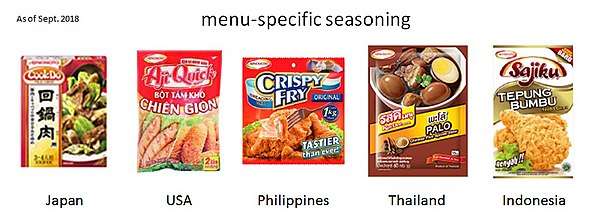
Processed Foods
With regard to processed foods, the main products developed by Ajinomoto co., Inc. are soup, mayonnaise, porridge, pasta sauce, and instant noodles. In Japan, soup was released under the "Knorr® brand" in 1964, in Taiwan and Brazil in 2005, and under the “VONO®” brand name in Korea in 2006. The first sales of their mayonnaise in Japan began in 1968, expanding to Vietnam in 2005, and Indonesia in 2012. Rice porridge was released in Japan as part of a series of retort foods in 1988. In addition, through their partnership with Kellogg in the USA, for nearly 50 years, the company has become the main sales vehicle for Kellogg's products in Japan. As for instant noodles, beginning in 1973 with their first overseas expansion to Thailand, Ajinomoto co., Inc. now produce noodles in Brazil, Peru, India, and Poland. In Peru, they also entered the cup noodle market in 2016.[46] Before the eventual publicity, the conglomerate was founded on Ikeda's work: it was the first to suggest that industrially purified glutamic acid salts, residues or analogues, originally found in seaweed or dried fish-based broth, might have a characteristic taste of its own. That idea was rapidly connected to the much older Japanese, culinary term of umami. This led to early adoption of MSG as a culinary agent in Japan. Ajinomoto is the world's largest manufacturer of MSG.[47]
Frozen Foods
Ajinomoto group entered the frozen food business in 1972 and went on to expand into an integrated sales company in 2000 in Japan, founding Ajinomoto Frozen Foods Co., Ltd. They established companies for frozen foods business in Thailand in 2004 and in China in 2014. and in 2014 acquired Windsor Quality Holdings Co., Ltd., the No. 1 frozen food supplier of Asian food in the United States. They expanded their line-up of dumplings, noodles, cooked rice etc.[48] Following that, in April 2015 they integrated their North American businesses by establishing Ajinomoto Windsor, Inc., and in 2018 changed the name to Ajinomoto Foods North America, Inc. Today, Ajinomoto holds 31% of the North American Asian frozen food market, the largest in the U.S.[49] They have continued to strengthen their global production and sales structure, including the establishment of Ajinomoto Jawo Sp. z o.o, a joint venture in Poland in 2014, and the acquisition of French Labeyrie Traiteur Surgelés S.A.S. in France in 2017.

Coffee, Non-Alcoholic Beverages and Powdered Drinks Business
In 1973, Ajinomoto Co., Inc. entered the coffee business through a joint venture with General Foods Corporation in the United States and developed products in new categories such as instant coffee, regular coffee, bottled coffee, and stick coffee. It became a 100% subsidiary of Ajinomoto Co., Inc. in October 2015, changing the name from " Ajinomoto Co., Inc. General Foods" to "Ajinomoto AGF Corporation" in July 2017.[50]
In 1993, they released the first canned coffee in Thailand subsequently creating a new canned coffee market. They are now the top coffee brand in Thailand, taking a 70% share of the market.[51] In 2017, the Blendy brand entered the Indian powdered beverage market for the first time.[52]

Life Support Business
As part of their life support business, the Ajinomoto Group develops and produces not only amino acids for use in livestock feed, cosmetics and detergents, but also electronic materials for use in insulators and flame retardants.
Animal Nutrition
Domestic animals are raised mainly on corn, wheat, soybean meal and other feeds, but by on their own, these feeds tend to lack essential amino acids such as Lysine, Threonine, and Tryptophan. Encouraging domestic animals to ingest the necessary amount of these acids not only increases costs but also the amount of arable land necessary for production. Moreover, unnecessarily increased nitrogen compounds due to the poor balance of amino acids can also cause environmental problems. From the 1960s, a new method to assist in the growth of livestock was established. It added the amino acids that tend to be insufficient in general feed. [53]
 Mechanism of greenhouse gas
Mechanism of greenhouse gas Economizing on soybean meal and land
Economizing on soybean meal and land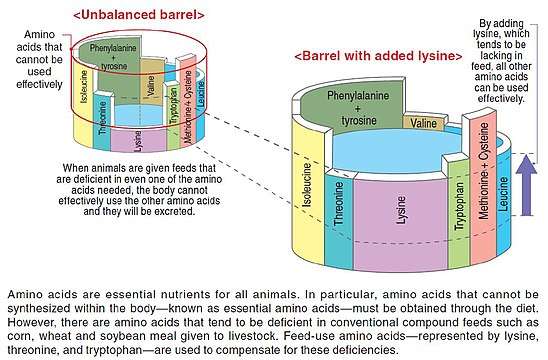 The Barrel Theory of amino acids
The Barrel Theory of amino acids
Under these circumstances, the Ajinomoto Group, which has been engaged in business and research of glutamic acid since its foundation, started an animal nutrition business in 1965 and subsequently established an international production and supply system for amino acids to be used in feed. As of 2017, the Ajinomoto Group's animal nutrition business has production and sales bases in six countries around the world, including Ajinomoto Eurolysine SAS (France), Ajinomoto Animal Nutrition North America, Inc., and Ajinomoto Animal Nutrition / Singapore. They are developing together as AJINOMOTO ANIMAL NUTRITION GROUP, the world's largest global network that supplies amino acids and customer service to various regions. [54]
Even if the missing Lysine, Threonine, Tryptophan or similar is administered in its natural form, it would still be decomposed by the stomach. In order to solve this problem, Ajinomoto developed a Lysine preparation called "AjiPro ®-L" for lactating dairy cows, which allows the Lysine to reach the intestine without being broken down in the stomach. Marketing began in North America from 2011, with sales in Japan taking off in April 2015. The company is also considering expanding sales across Asia, the Middle East, and Oceania. [55]

Specialty Chemicals
In terms of the development of specialty chemicals Ajinomoto has developed mild cleansing agents such as "Amisoft®" which is made from glutamic acid and coconut fatty acid, "Amilite ®" born from alanine and natural fatty acids, humectant emollients such as "Eldew ®” , which is derived from glutamic acid. And "Amihop®", which is made from Lysine and fatty acid can be widely applied to make-up, skin care, and hair care to be sold to cosmetic manufacturers and toiletry makers as raw materials. The market for such natural cosmetic products is expanding globally and a growth in sales is especially expected in local companies in Indonesia. Ajinomoto Co., Inc. also conducts manufacture on assignment (OEM) for companies such as Daiichi Sankyo Healthcare Co., Ltd. for the development of their moisturizing detergent "Minon ®". In terms of electronic fabricated materials, Ajinomoto has been developing their resin functional materials business using the technology obtained through the production of sodium glutamate. However, they have also developed interlayer insulating materials for semiconductor packages, known as " Ajinomoto Build- up Film " (ABF). ABF is contributing to improving the performance of personal computers, acting as an insulating film necessary for the manufacture of a computer’s semiconductor package. The company is expanding its application of the technology to cover smartphones and tablet computers. Furthermore, based on the ABF technology, Ajinomoto recently developed an encapsulating material called " Ajinomoto Encapsulation Film" (AEF) which can be used in organic EL devices, a field that is expected to be the next generation of lighting and display technology. The products are expected to shorten the manufacturing process of organic EL devices thus contributing to the improvement of product durability. In addition, functional chemicals, activated carbon, release paper and the like have also been commercialized based on knowledge obtained from the research on and production of amino acid processes.
Other Business
Sweeteners
In 1982, Ajinomoto Co., Inc. launched the amino-acid based sweetener aspartame, and entered the sweetener business. In 1984 they released a low-calorie consumer sweetener "PAL SWEET." Ajinomoto Co., Inc. is the world's largest manufacturers of aspartame, sold under the trade name Aminosweet. It acquired its aspartame business in 2000 from Monsanto for US$67,000,000.[31] As of 2018, the Ajinomoto Group's aspartame-based sweetener business is now deployed in approximately 80 countries around the world, corresponding to the low calorie, reduced sugar, and increasingly health conscious needs of consumers, while also reducing the negative impact on the environment. In addition, in 2011, Ajinomoto Co., Inc. developed " Advantame" which is about 30,000 times sweeter than sugar. It is now sold in markets globally, including the United States, Europe, Japan, and Taiwan.
Amino Acid Supplements
In addition to glutamates as a seasoning, the company also produces other amino acids such as L-Leucine, L-Tyrosine, Glycine, L-Phenylalanine,[56] and several others, which it markets as dietary supplements under the brand name AjiPure.[57][56]
Corporate governance
As of June 2015, the president and CEO of Ajinomoto is Takaaki Nishii.
Ajinomoto’s chairman since June 2005, Kunio Egashira, died on April 7, 2008.[58] Egashira had previously served as the company's president from June 1997.[58]
Organization
According to the Global Corporate website, there are three major types of subsidiaries based on the products they produce: Seasonings and Processed Foods, Frozen Foods and Amino Acids; the number of subsidiaries in each category number 27, 9 and 12, respectively, and most are geographically defined entities.[59]
Ajinomoto North America, Inc. is a wholly owned subsidiary of Ajinomoto.[60] It is headquartered in Fort Lee, New Jersey and covers operations in the United States, Mexico and Canada.[61] According to the company, it is the "only pharmaceutical L-amino acid manufacturer in the United States."[60]
Ajinomoto has three divisions devoted to chemical manufacture outside of the amino acid manufacturing area: NaturalSpecialities and Tensiofix are subunits of Omnichem, which is headquartered in Belgium.[62][63][64]
See also
- Ajinomoto Stadium
- Calpis
- Monosodium glutamate
- Glutamate flavoring
- Kikunae Ikeda
- Umami
- Tien Chu Ve-Tsin
- Glutamic acid
- Disodium glutamate
- Monopotassium glutamate
- Disodium inosinate
- Guanosine monophosphate
- Inosinic acid
- Adenosine monophosphate
- Aspartame
- Aspartame controversy
- Motoko-chan no Wonder Kitchen,
(company video game)
References
- 1 2 3 4 5 6 7 8 "Financial Report for the fiscal year ended March 31, 2018" (PDF). Ajinomoto Group. Retrieved 2018-03-31.
- ↑ Sand, Jordan (2005). "A Short History of MSG". Gastronomica. 5 (4): 38&ndash, 49. doi:10.1525/gfc.2005.5.4.38. JSTOR 10.1525/gfc.2005.5.4.38. (subscription required)
- ↑ "Toward the realization of "Ajinomoto Group Zero Emissions" Chuo Ace Logistics Corporation achieves "Green Management Certification" Chuo Ace Logistics Corporation promotes environmentally friendly logistics" (Press release). Ajinomoto. November 1, 2004. Retrieved February 12, 2010.
- ↑ https://www.ajinomoto.com/en/aboutus/history/ 『100 years of the AJINOMOTO GROUP』Introduction(in English):Retrieved 20 December 2017
- ↑ “Umami taste receptor identified”. Nature. February 2007. Retrieved 26 June 2013.
- ↑ 『100 years of the AJINOMOTO GROUP』,2009,P3
- 1 2 『Short History of MSG』, jordan sand, 2015 Fall Gastronomica P38
- 1 2 https://www.ajinomoto.com/en/aboutus/history/Docudrama Commemorating the Centennial of the Discovery of Umami 『AMBITION』
- 1 2 3 https://www.ajinomoto.com/jp/aboutus/history/『100 years of the AJINOMOTO GROUP』Chapter 1(in Japanese): Retrieved 20 December 2017
- 1 2 https://www.ajinomoto.com/en/aboutus/data/ Retrieved 20 December 2017
- 1 2 https://www.ajinomoto.com/jp/aboutus/history/chronology/ Retrieved 20 December 2017
- ↑ https://www.ajinomoto.com/jp/aboutus/history/『100 years of the AJINOMOTO GROUP』Chapter 2 Overcoming Difficulties(in Japanese): Retrieved 20 December 2017
- ↑ https://www.ajinomoto.com/jp/aboutus/history/『100 years of the AJINOMOTO GROUP』Chapter3 Progressing: Retrieved 20 December 2017
- ↑ http://ocw.u-tokyo.ac.jp/lecture_files/eco_05/2/notes/en/CEHJ-14.pdf: Retrieved on 20 February 2018
- 1 2 https://www.ajinomoto.com/jp/aboutus/history/『100 years of the AJINOMOTO GROUP』Chapter4 During World War Ⅱ: Retrieved 20 December 2017
- ↑ https://www.ajinomoto.com/jp/aboutus/history/『100 years of the AJINOMOTO GROUP』Chapter5 Business Development after World War Ⅱ: Retrieved 20 December 2017
- ↑ http://www.ajinomoto.com/en/aboutus/history/chronology/ Retrieved 20 February 2018
- ↑ https://www.ajinomoto.com/jp/aboutus/history/『100 years of the AJINOMOTO GROUP』Chapter 5 5-6 List of business expansion(in Japanese): Retrieved 20 December 2017
- 1 2 http://www.ajinomoto.com/jp/aboutus/history/chronology/ :Retrieved 20 December 2017
- 1 2 https://www.ajinomoto.com/jp/aboutus/history/『100 years of the AJINOMOTO GROUP』Chapter 7 Measures towards safety and global expansion:Retrieved 20 February 2018
- ↑ https://www.ajinomoto.com/jp/aboutus/history/『100 years of the AJINOMOTO GROUP』Chapter 6 Diversification and Globalization: Retrieved 20 February 2018
- ↑ http://www.ajinomoto.com/en/ir/library/fact/main/0/teaserItems2/0/file/Food-Oct2017.pdf Retrieved 20 December 2017
- ↑ https://en.wikipedia.org/wiki/Japanese_yen#Effect_of_the_Plaza_Accord
- 1 2 3 https://www.ajinomoto.com/jp/aboutus/history/『100 years of the AJINOMOTO GROUP』Chapter 8 Business expansion and restructuring: Retrieved 20 February 2018
- ↑ Bell, Meredith E.B.; Laskin, Elena (1999). "Antitrust Violations". American Criminal Law Review. 36 (3). (subscription required)
- ↑ A Summary Overview of the Antitrust Division's Criminal Enforcement Program (Speech). Presented by James M. Griffin. James M. Griffin, Deputy Assistant Attorney Gen., Antitrust Div., Dep't of Justice, [ : A Summary Overview of the Antitrust Division's Criminal Enforcement Program], Aug. 12, 2003.
- ↑ Corporate identity April 6, 2018.
- ↑ 『100 years of the AJINOMOTO GROUP』Chapter 7 Countermeasure for Safety and Globalization: Retrieved 20 February 2018 Retrieved 20 February 2018
- ↑ Ajinomoto Newsletter vol.4, Dec.5.2017
- ↑ 『100 years of the AJINOMOTO GROUP』Chapter 9 Towards a global company from Japan: Retrieved 20 February 2018
- 1 2 "Sweetener sale-05/06/2000-ECN". ICIS. Reed Business Information. June 5, 2000. Retrieved July 9, 2010.
- ↑ Time.com
- 1 2 Perri, Celeste; Sekioka, Tomomi (January 12, 2006). "Danone Sells Amoy to Japan's Ajinomoto for EU190 Mln (Update2)". Bloomberg.com. Retrieved June 14, 2013.
- ↑ Craven, Neil (May 4, 2008). "Asda gears up for additives battle/ aspartame". Mail Online. Associated Newspapers. Retrieved June 23, 2010.
- ↑ "Asda claims victory in aspartame 'nasty' case". www.foodanddrinkeurope.com. Retrieved 2010-06-23.
- ↑ "Court of Appeal rules in Ajinomoto/Asda aspartame case". www.foodbev.com. Retrieved 2010-06-23.
- ↑ "Radical new twist in Ajinomoto vs Asda 'nasty' battle". www.foodnavigator.com. Archived from the original on 6 June 2010. Retrieved 2010-06-23.
- ↑ Bouckley, Ben (May 18, 2011). "Asda settles 'nasty' aspartame legal battle with Ajinomoto". William Reed Business Media SAS. AP-FoodTechnongy.com. Retrieved July 18, 2011.
- ↑ http://holylandgroup.com
- ↑ https://www.ipabindia.org/ManagePDF/IPAB/filePDF/Causelist_9699_3183.pdf
- ↑ Kachi, Hiroyuki (May 8, 2012). "Asahi to Buy Calpis for $1.5 Billion". The Wall Street Journal. Retrieved June 14, 2013.
- ↑ "Ajinomoto Moves into CDMO Market". News: Inside Industry. Genetic Engineering & Biotechnology News. April 1, 2013. p. 12.
- ↑ https://www.ajinomoto.com/en/presscenter/press/detail/g2017_10_02.html
- ↑ 紀子, 河野. "味の素、もう「Aji-no-moto」だけに頼らない ベトナムで挑む、ウメと抹茶で需要発掘". 日経ビジネスオンライン (in Japanese). Retrieved 2018-07-04.
- ↑ "味の素、ブラジルで粉末調味料「サゾン」生産能力増強". 日本経済新聞 電子版 (in Japanese). Retrieved 2018-07-04.
- ↑ "味の素(株)、中南米のカップ麺市場に新規参入 2016年6月20日より販売開始~ペルー自社工場敷地内にカップ品種専用工場を建設~". プレスセンター | 味の素グループ | 味の素(株)、中南米のカップ麺市場に新規参入2016年6月20日より販売開始~ペルー自社工場敷地内にカップ品種専用工場を建設~ (in Japanese). Retrieved 2018-07-04.
- ↑ Rosner, Helen (27 April 2018). "An MSG Convert Visits the High Church of Umami". The New Yorker. Retrieved 30 April 2018.
- ↑ https://www.ajinomoto.com/jp/ir/event/business_briefing/main/05/teaserItems1/00/linkList/0/link/Presentation_J_0910.pdf
- ↑ https://www.ajinomoto.com/jp/ir/library/fact/main/0/teaserItems2/0/file/Food-Oct2017.pdf
- ↑ "味の素AGF", Wikipedia (in Japanese), 2018-07-04, retrieved 2018-07-24
- ↑ "味の素社、タイのトップブランド「Birdy(R)」缶コーヒー第2工場稼働 旺盛な需要に応えて、安定供給体制を構築〜投資額45億円、本年7月より本格稼働〜". プレスセンター | 味の素グループ |味の素社、タイのトップブランド「Birdy(R)」缶コーヒー第2工場稼働 旺盛な需要に応えて、安定供給体制を構築〜投資額45億円、本年7月より本格稼働〜 (in Japanese). Retrieved 2018-07-24.
- ↑ https://www.ajinomoto.com/jp/ir/news/news-1350724205145957461/main/0/link/2017_08_10_J.pdf
- ↑ Leuchtenberger W, Huthmacher K, Drauz K (November 2005). "Biotechnological production of amino acids and derivatives: current status and prospects". Applied Microbiology and Biotechnology. 69 (1): 1–8. doi:10.1007/s00253-005-0155-y
- ↑ https://www.ajinomoto.com/jp/presscenter/press/detail/2002_06_11_2.html
- ↑ https://www.ajinomoto.com/en/activity/csr/pdf/2015/ajinomoto_csr15_digest.pdf
- 1 2 "AjiPure®—Better Amino Acids Make Better Proteins". Swanson Vitamins online store. Retrieved 14 June 2017.
- ↑ "About Our Company". AjiPure official website. Retrieved 14 June 2017.
- 1 2 Uranaka, Taiga (April 9, 2008). "Ajinomoto chairman Kunio Egashira, 70, dies". Reuters. Retrieved 2008-04-19.
- ↑ "Major Subsidiaries and Affiliates". Ajinomoto Group. Ajinomoto. October 2012. Retrieved June 17, 2013.
- 1 2 "Labeled Amino Acids, Pharmaceutical Grade Amino Acids, Amino Acid Production". Ajinomomoto Amino Acid Technologies. Ajinomoto. 2013. Retrieved June 17, 2013.
- ↑ "Labeled Amino Acids, Pharmaceutical Grade Amino Acids, Amino Acid Production". Ajinomomoto Amino Acid Technologies. Ajinomoto. 2013. Retrieved June 17, 2013.
- ↑ "Contact us". Tensiofix Surfactant for Agrochemical. Ajinomoto. Archived from the original on May 3, 2013. Retrieved June 17, 2013.
- ↑ "Contact us". Ajinomoto NaturalSpecialities - Polyphenols, tannic acid, gallotannins, custom extraction of botanicals, grape seed extract. Ajinomoto. Archived from the original on August 10, 2013. Retrieved June 17, 2013.
- ↑ "Home". Omnichem. Ajinomoto. 2007. Archived from the original on June 27, 2013. Retrieved June 17, 2013.
External links
- Ajinomoto Group - Global
- Ajinomoto - English
- "Company history books (Shashi)". Shashi Interest Group. April 2016. Wiki collection of bibliographic works on Ajinomoto
